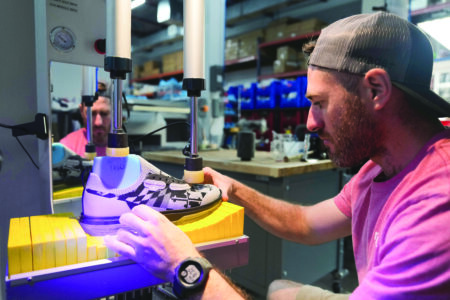Email etiquette
Correct way to compose a letter taught at NMU event

There’s a right way and a wrong way to email a professor. Proper etiquette was discussed at a recent event by Northern Michigan University’s Multicultural Education and Resource Center. (Journal photo by Christie Bleck)
MARQUETTE — If you want to make a good impression with your professor, don’t use profanity in an email.
That might seem obvious, but to a college student who might be inexperienced in the ways of the world, an occasional reminder in teacher-pupil etiquette probably can’t hurt.
Stephany Madrid, Jump Start team leader with Northern Michigan University’s Multicultural Education and Resource Center, presented a “Coffee and Conversation” workshop on Thursday at Jamrich Hall on the basics of composing proper emails to professors as well as in professional settings.
Madrid, a sophomore majoring in applied behavior analysis, talked about how an email should begin and end, and what its contents should be.
The introduction, she said, should address the professor or adviser with the proper name.
“Most professors will tell you on the first day if they’re a doctor or what to call them,” Madrid said. “Especially if they’re a doctor, you should call them that.”
As in many situations, first impressions can be important.
Madrid believes a “good morning” or “good afternoon” should be included in the introduction as well, with “dear” saved for letters.
As far as the email contents are concerned, she suggested a student first check the syllabus before inquiring about a class matter.
“There is a chance that they probably already answered the question in the syllabus,” Madrid said, “and sometimes professors will email you back, just to check the syllabus, and some won’t even email you at all and just assume that you’ll look.”
Students also should identify themselves and the courses they’re taking in the emails; with the large number of students, chances are professors won’t recognize email composers, especially if there have been only a few emails exchanged, she said.
Madrid recommended students get straight to the point.
“Ask the question you need to ask,” she said. “Don’t put filler because professors don’t want to read that.”
Madrid also suggested the subject line contain the course and section.
Signing off is easy, she said, with “best,” “kindest regards” and “thank you” followed by the student’s name the way to go.
Running the email through a spell-check is another good idea to have the proper grammar and punctuation, she said.
However, some things a spell-check can’t catch, so students have to have some knowledge of email prose.
“Try not to use contractions,” Madrid said.
She showed several examples of “good” and “bad” emails, with the differences being painfully obvious. The cautionary examples, for example, included snide remarks and in appropriate sarcasm.
Madrid said if a student doesn’t want to use email, visiting a professor during his or her office hours is an option.
Madeline Wiles, a supervisor at the MERC, said Madrid strongly believes students should understand how to compose an appropriate email.
“I think this is very crucial information that students need, and I don’t think this is taught a lot,” Wiles said.
The MERC partners with students, faculty, staff and alumni to promote cultural diversity on campus. For more information on the MERC, located at 3001 Hedgcock, visit nmu.edu/multiculturaledandres/home-page, email merc@nmu.edu or call 906-227-1554.





